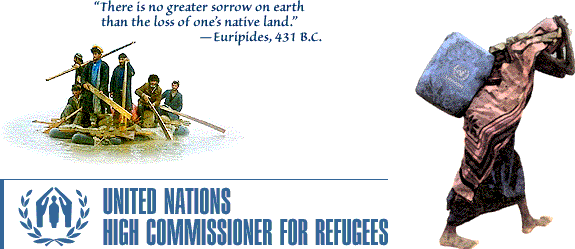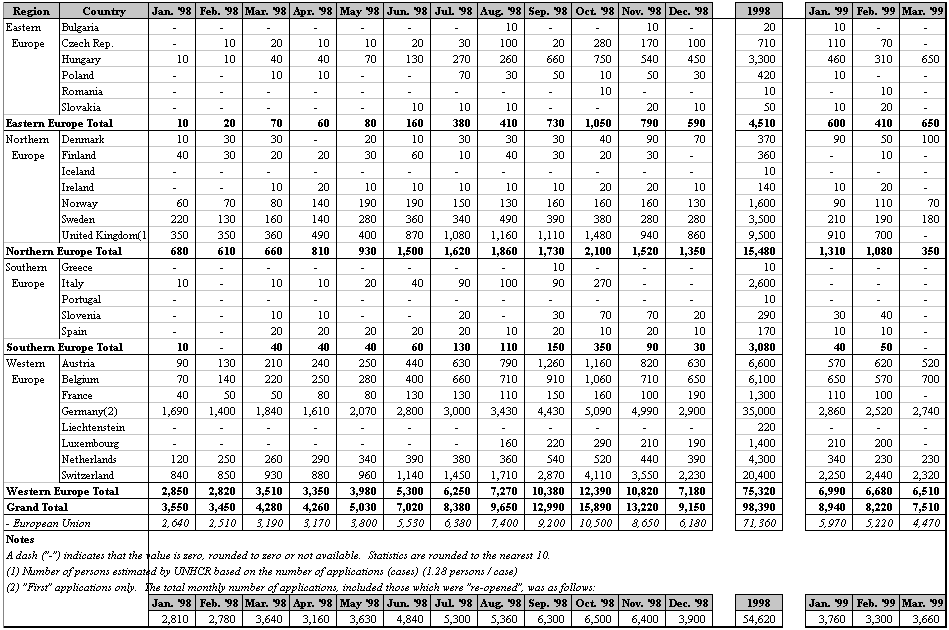| 12 April 1999 |
|
AT A GLANCE
- Over the weekend of 10-11 April, there were nearly 4,300
new arrivals crossing the Morini border into Albania. During the same period, around 3,600
arrived in Montenegro and 300 in Macedonia (see tables below for UNHCR estimated
figures as at 12 April 1999, 08:00 GMT)
- Around 3,200 refugees were evacuated from Macedonia by air
over the weekend to Germany, Norway, Poland and Turkey, bringing the total moved out of
Macedonia by air to 7,987.
MAJOR DEVELOPMENTS
ALBANIA
Albania received nearly 4,300 new arrivals during the
weekend, coming from villages west of Pristina. These new refugees followed the arrival at
the Morini border crossing already during the night of Friday to Saturday (9-10 April) of
a group coming from the village of Vragolija, located just west of Pristina. During the
day on Saturday 10 April, 88 persons arrived from Prizren and on Saturday evening, another
4,200 refugees came through the Morini border. The latter group came from small hamlets
west of Pristina in the Kosovo Polje municipality. Another 28 refugees from Prizren
arrived on Sunday.
The refugees from the villages west of Pristina said they
were told to leave by the Serbian security forces. They were allowed to take their
vehicles with them and though they had to pass through many check points, no violence was
used against them during their journey. As with previous groups, their identification
papers and car number plates were taken away, but medical agencies working with UNHCR at
the border reported the refugees were in relatively good physical condition on arrival.
The estimated total number of refugees in Albania is now
309,500. Of this figure, UNHCR estimates that no more than 80,000 remain in the Kukes
area, as the Albanian authorities continue to move refugees out of Kukes to other parts of
the country, with the help of aid agencies.
Around 6,000 refugees who had been temporarily housed in
four schools in Kukes were moved out over the weekend to enable the schools to reopen.
Many refugees were bussed to central Albania, while those wishing to stay in Kukes were
taken to other collective accommodation centers in the area.
Several cases of measles have been confirmed among refugee
children in Kukes. UNICEF, with the support of non-governmental agencies, will launch a
vaccination campaign starting Tuesday, 13 April.
The food situation for refugees in the Kukes area is
improving, with humanitarian rations and other supplies arriving on trucks and on
helicopters made available to UNHCR and other agencies by various governments for ferrying
supplies from Tirana to the north of the country.
UNHCR is currently discussing with the Albanian government
and other agencies present in the country procedures for carrying out a country-wide
registration of the Kosovar refugees.
MACEDONIA (FYROM)
The border was closed again on Sunday 11 April, after 380
refugees arrived on Saturday. 300 of them crossed at Jazince and another 81 refugees at
Blace, after walking down the railroad tracks to avoid landmines.
The refugees arrived from Urosevac town, but originally
came from the village of Sojevo. They said that they had first been expelled from their
village by paramilitary forces who gave them 5 minutes to leave. Most villagers fled into
the hills, but they said that one handicapped person and his wife and three others who
couldn’t run fast enough were shot. After the group had spent two days in the hills
they were flushed out by paramilitaries and told to line up in the village. They were
robbed of their valuables and forced to buy tickets to go to Macedonia. Those who
couldn’t pay for the trip reportedly had to walk to the border.
Over the weekend, UNHCR started a comprehensive
registration of the refugees staying in the Brazda camp. This tent-to-tent registration
will subsequently extend to other camps in Macedonia. It is being carried out with OSCE
assistance by roving teams. There will be no registration points, in order to avoid long
lines and waiting periods. This general registration will replace the separate
registration used earlier for candidates for evacuation. It will provide vital data about
the refugee population as well as information relevant for the eventual evacuation of
refugees to other countries.
MONTENEGRO (FRY)
Arrivals of displaced people from Kosovo in Montenegro
continued over the weekend. Around 1,500 arrived on Saturday, another 1,100 arrived on
Sunday morning and another 1,000 on Sunday afternoon and evening. All arrived by foot at
Rozaje, and all came from the Istok area.
The border town of Rozaje is increasingly packed with
displaced people. Over 14,000 new arrivals are staying there, placing a severe strain on
accommodation facilities and raising concerns about sanitation. Industrial sites providing
temporary shelter are full to capacity, with most recent arrivals being directed to the
Napredak and Dekor factories. Some 6,000 Kosovars are housed in factories, 1,000 in
mosques and 7,000 in private houses.
UNHCR is providing plastic sheeting to enable displaced
people to stay temporarily in unfinished buildings. Many of the displaced people
subsequently move onward to the coastal municipality of Ulcinj, which now hosts over
21,000 displaced people from Kosovo.
There are over 63,000 displaced people from Kosovo staying
in Montenegro.
HUMANITARIAN EVACUATION
UNHCR coordinated the evacuation of 3,200 refugees from
Macedonia over the weekend. Refugees travelled to Germany, Norway, Poland and Turkey. The
total number of refugees evacuated so far since the airlift began on 7 April is 7,987.
This includes 1,980 (number subject to verification) evacuated in bilateral arrangements
between Macedonia and Turkey, before UNHCR/IOM co-ordination of the airlift began.
To date, Germany has admitted the largest number of
refugees — over 4,400 — with Turkey having taken in over 3,000. Another 1,300
refugees are to be evacuated on Monday 12 April.
|
|
|



 Document compiled by Dr S D Stein
Document compiled by Dr S D Stein